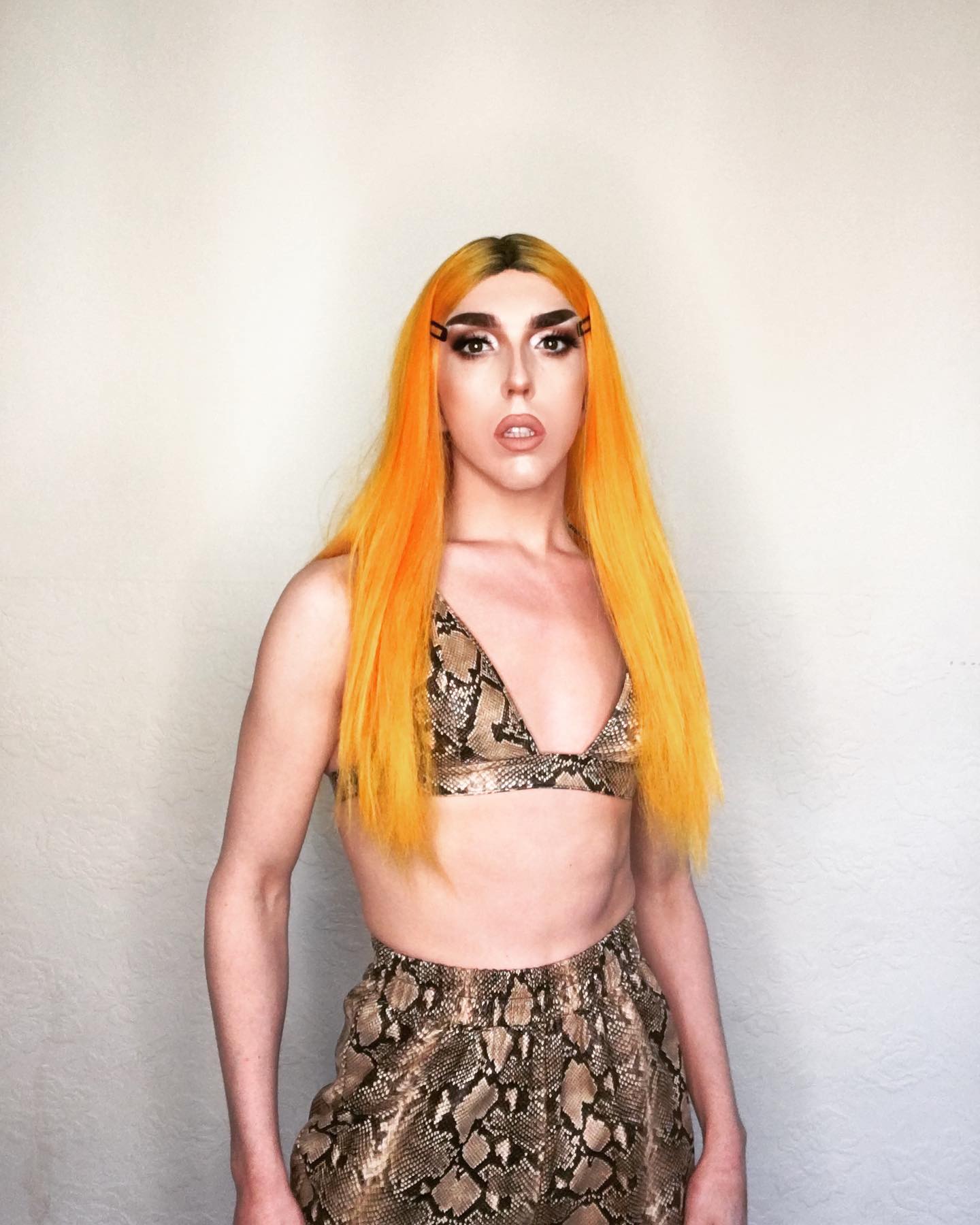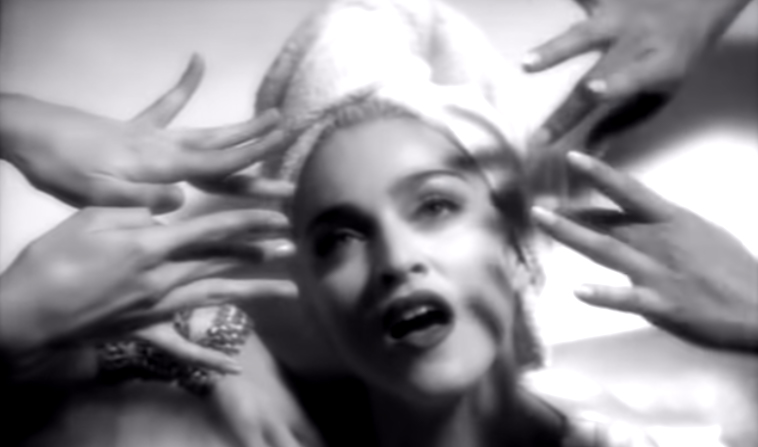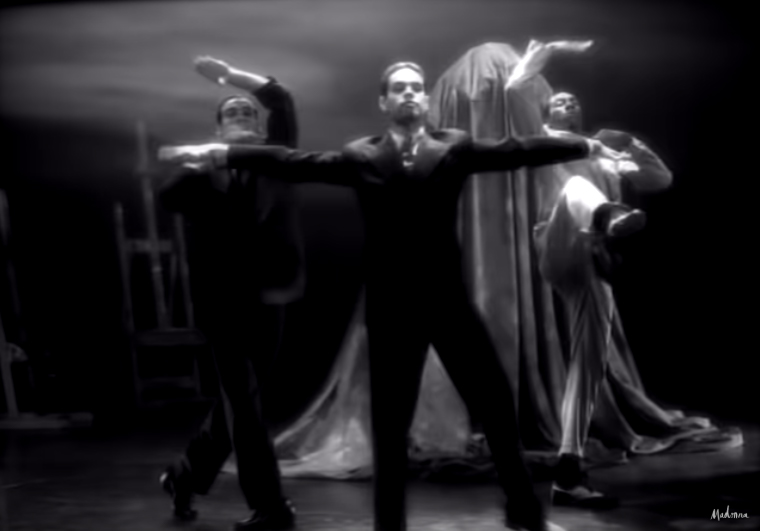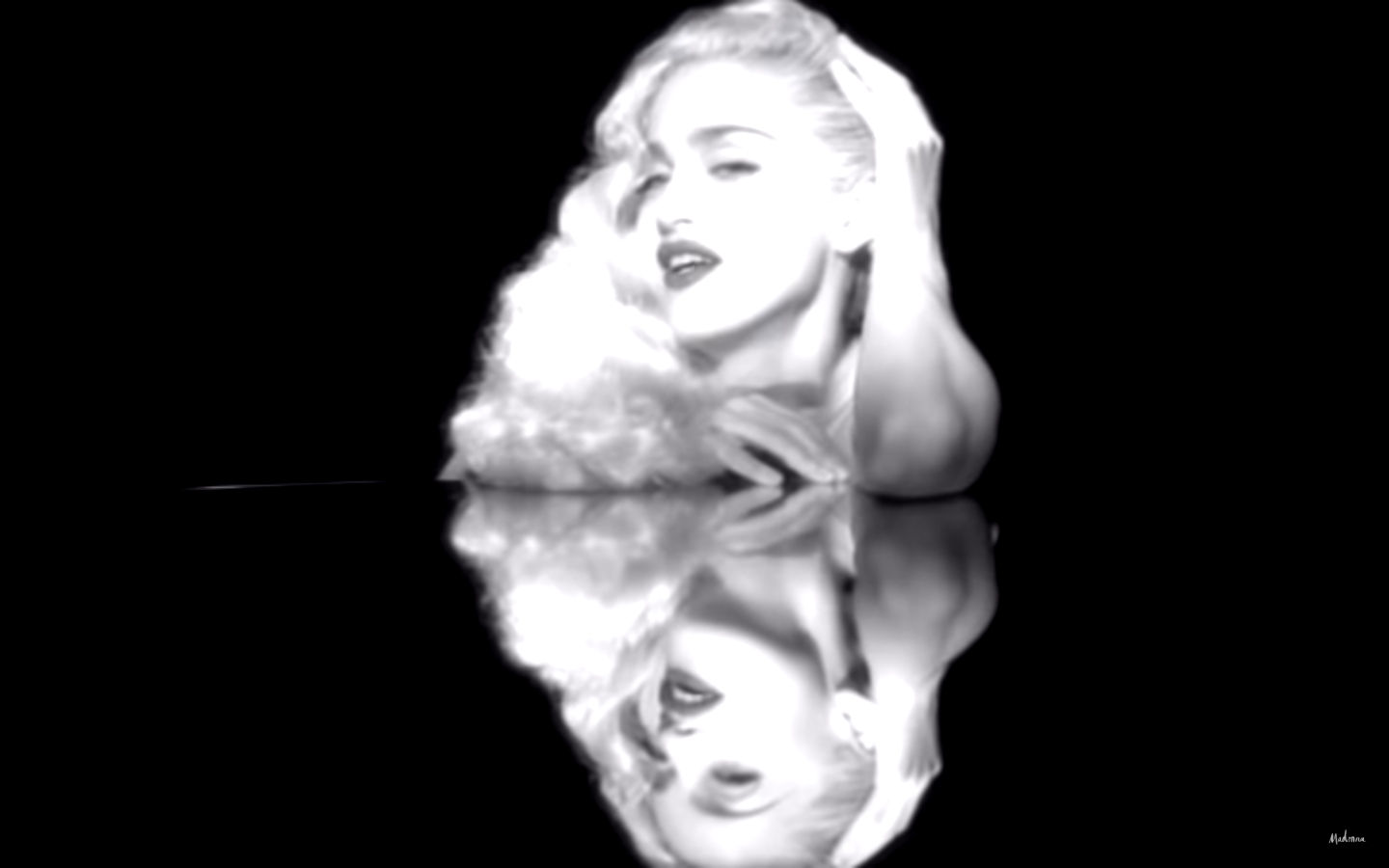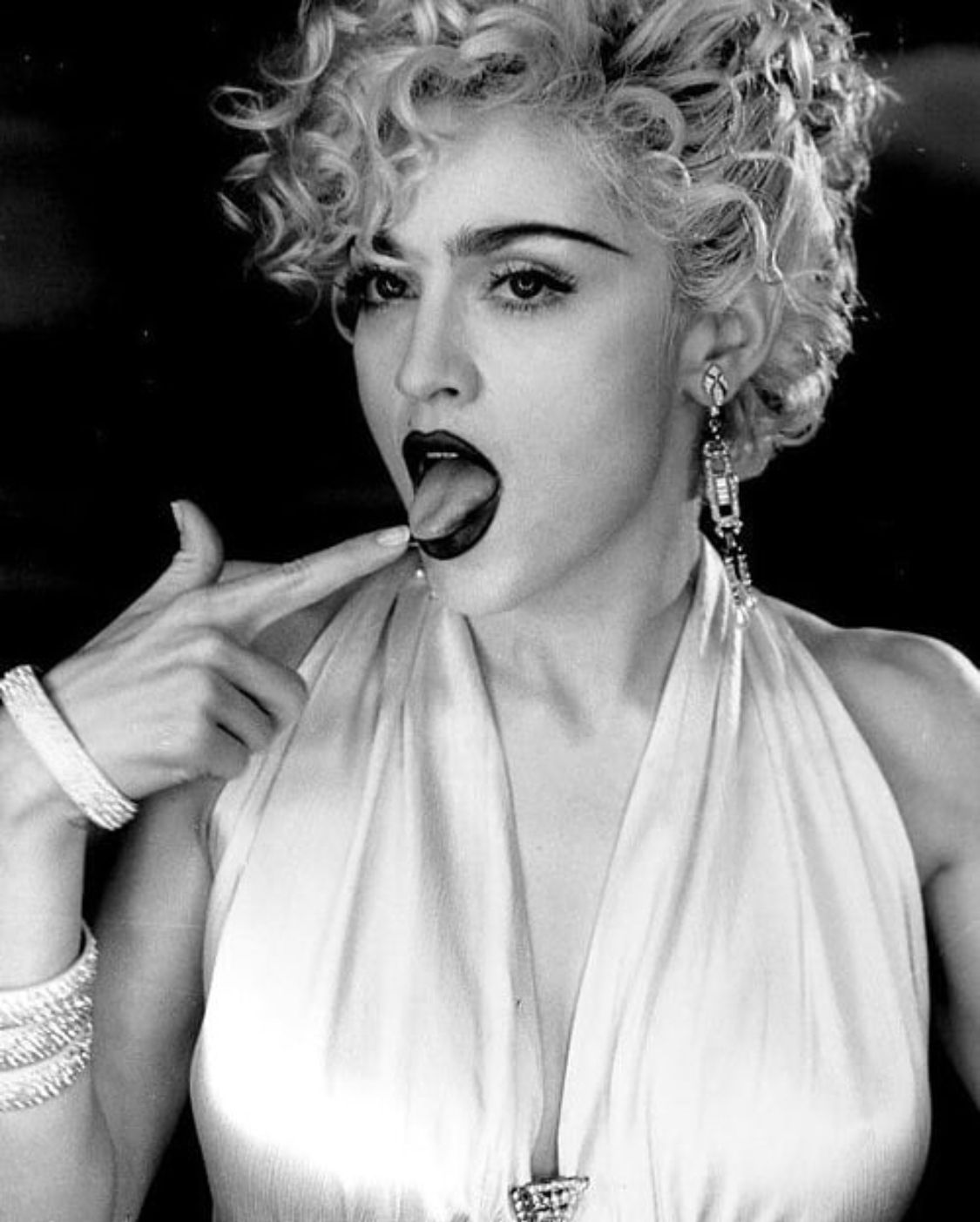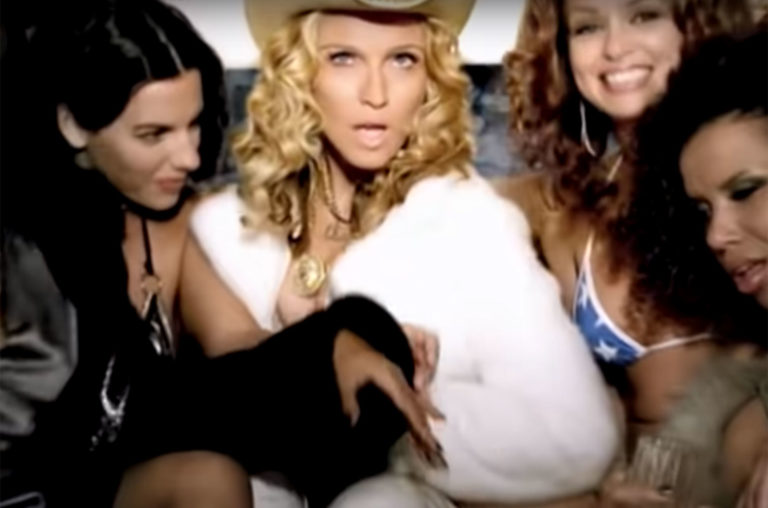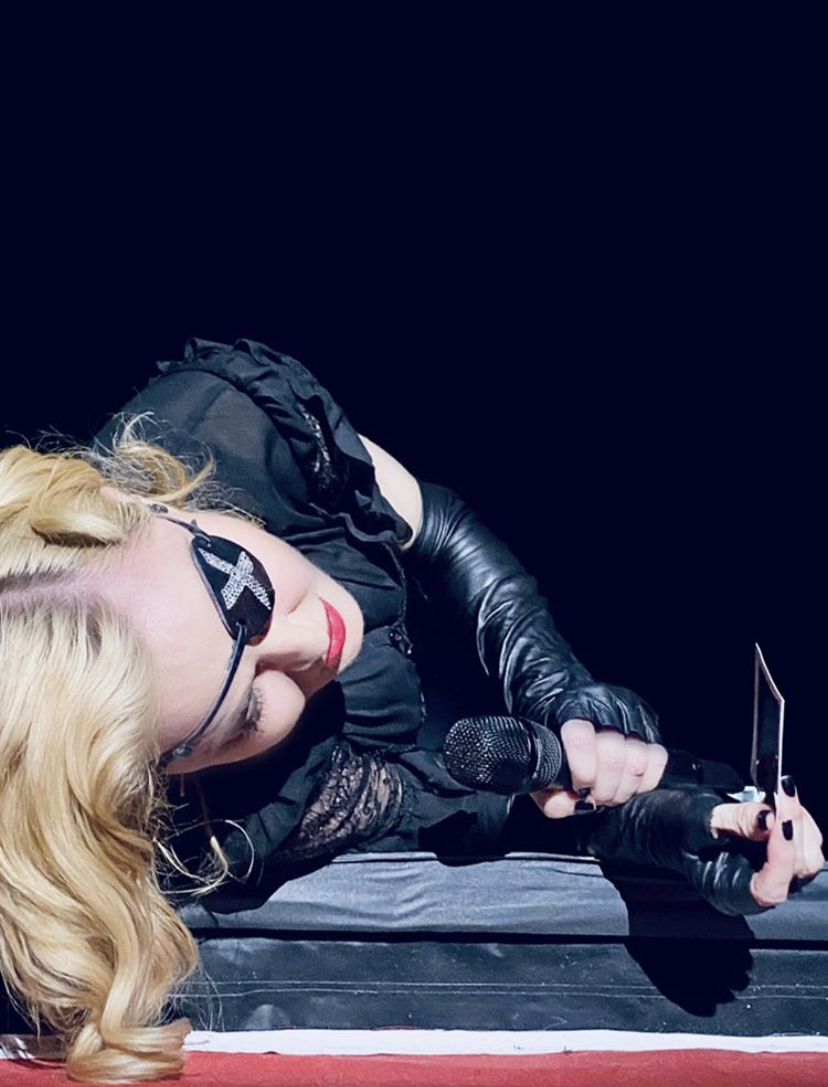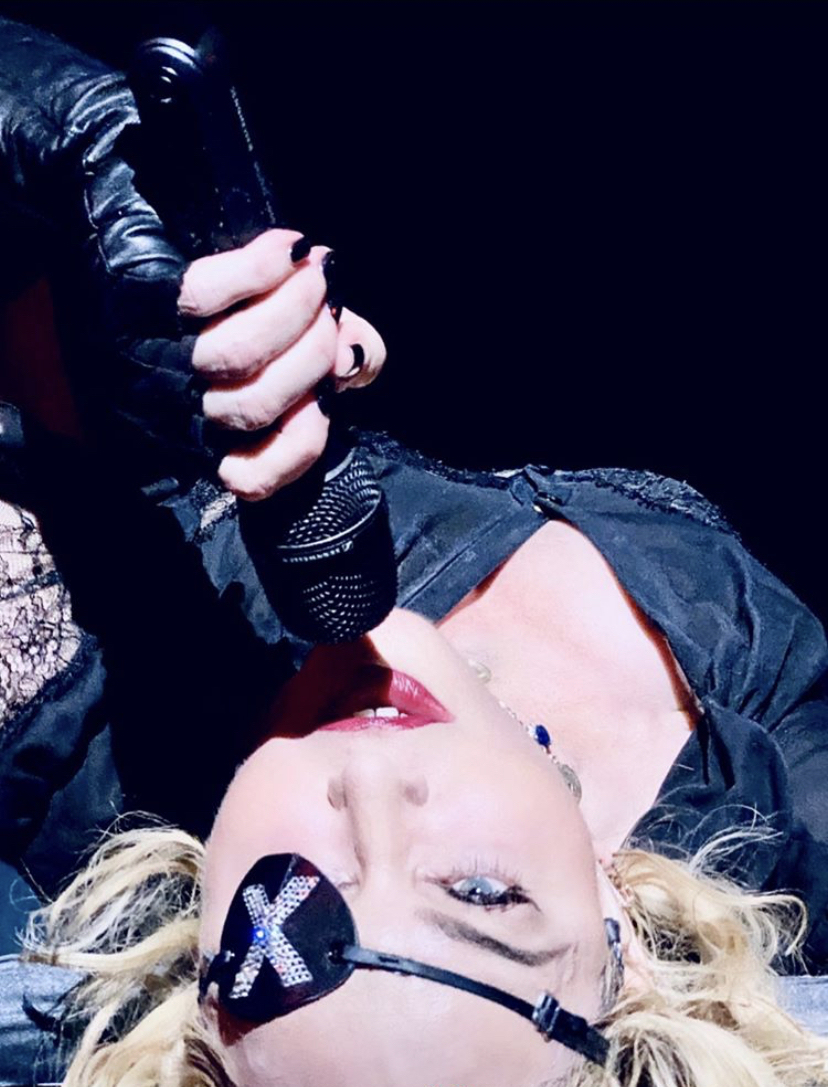| |
Madonna news - March 2020
← Feb. 2020 | April 2020 →
Dub remixes and 12" version of Vogue added on Youtube
Source: Youtube - 31 March 2020In the wake of the 30th anniversary, Madonna's team has added three alternative versions of Vogue to her official Youtube channel: the fan favourite 12" version, as well as the Bette Davis Dub and Strike a Pose Dub. Go ahead and give them some more views.
Madonna - Vogue (12" version)
Madonna - Vogue (Bette Davis Dub)
Madonna - Vogue (Strike a Pose Dub)
Celebrating 30 years of Madonna’s Vogue, the song that thrust queer culture into the mainstream
Source: PinkNews - 29 March 2020Margo Marshall is a trained classical dancer known for her explosive moves, seductive lip-syncs and glamorous androgynous looks.
She has performed on the BAFTAs, MTV Music Video Awards, The Graham Norton Show, Mighty Hoopla, Brooklyn's BUSHWIG Festival, Robyn's "Honey" Music Video and headlined The Unroyal Variety at Hackney Empire.
Writing for PinkNews on the anniversary of the 1990 song "Vogue" by Madonna, she pays tribute to the star's phenomenal influence on queer culture, from one entertainer to another.
Vogue is of course an iconic song, one of the few Madonna tracks that transcends even Madge's own infamy.
The anthem has everything, camp references, stylish visuals and a fun rap to scream in your friends face to PROVE YOU KNOW THE LYRICS (…why do we do this?). But once you scratch the frivolous surface, there is far more reason for the songs longevity and cultural importance.
The first time I became aware of a 'Madonna' I was watching a teachers talent show for Children in Need at school and my music teacher Miss Bailey 'performed' Frozen. Despite questionable vocals, I was entranced and had to hear more of this angelic mystical sound. I came home and was yapping about this thing I had discovered called 'Madonna' (surprise, I was a loud, obnoxious child).
My dad disappeared to his car and returned with my first M album Ray of Light. I listened to the poor thing til Madonna was as blue in the face as the album cover. And so began an obsession. I raced through album after album, Music, Like A Virgin, True Blue desperate for more. Then I listened to "Vogue"… and the world stopped.
The opening note hit in the air and buzzed through the room, my heart beat copied the build of the tracks soft thuds and then the bass kicked in. I squealed with relief, it had FINALLY started! Suddenly I had a new dream about "Vogue", gone was the desire to be an emaciated model in the pages of a boring magazine, I wanted to be a powerful, sexual, beautiful, aggressive QUEEN!
Unlike my gay childhood cliche, the origins of the notorious track are however somewhat more surprising. After a brilliant run of singles, "Like A Prayer", "Express Yourself" and "Cherish", her next song "Oh Father" from the 1989 album began to show a decline in sales. So Warner Bros approached Madonna's previous collaborator, Shep Pettibone, to create a B-Side with her for the next planned single "Keep It Together".
However just three weeks later, from a small 24-track recording studio in a basement closet of 56th street in Manhattan, "Vogue" dropped on their desk and the plan changed. This song was considered too good to waste. The track became the lead single on her album I'm Breathless accompanying her role in the film Dick Tracy, and went on to be the most sold song of 1990, with more than 600 million sales worldwide (wish I could do that with my B-side).
But why was it such a runaway success? Some have cited Pettibone's production style as a major reason for the track's popularity. Pettibone was an innovator in is his own right, known best for making remixes because of his revolutionary techniques. He elevated tracks, being one of the first to restructure songs and record new musical tracks, a staple of remixing today.
He was such a talented producer that Madonna even changed the release of "Express Yourself" to his mix shortly after premiering the music video, thus explaining the millions of different versions of "Express Yourself" (the bane of your life when you're a professional drag witch who does this as a number and DJs just play any old version instead of downloading your track).
This incredible talent for reimagining singles transferred to producing a highly distinctive yet timeless sound, in this case marrying classic golden era with house music. However I think there are a few other key things that have given "Vogue" its iconic status.
As a young queer in a rather less exciting part of the world, the song was my first taste of queer culture, not that I knew it.
I was focused on the glamours Hollywood stars, which in fairness has its own queer history to it as well. My family were pretty camp and so I knew the hit list names of Monroe, Dean and Kelly after spending endless Sundays watching old movies and jazzy musicals. But I had now discovered Marlene Dietrich, Greta Garbo and Bette Davis and avidly stared at photos of their dramatically poised faces and listened in wonder to their bizarre clipped mid-Atlantic accents.
'Vogue' has stood the test of time… acting as a beautiful cyclical exchange of tastes across generations of the queer community.
The rap section was Pettibone's idea in the studio, and although it moved away from original influence of the ballroom scene it rather beautifully added another layer to the songs queer-ism. The Golden Era references highlighted the importance of older queer icons and continues to educate younger generations like myself about people the older members of the scene used to look up to before Cher (yes twinks, it's hard to imagine gayness before Cher, I know).
As a dance track, "Vogue" has stood the test of time, continuing to still be played and acts a beautiful cyclical exchange of tastes across generations of the queer community.
On the subject of our queer community. THE BALLROOM.
Immediately I get flashes in my mind from Paris is Burning which of course recently came to Netflix, and with the song's heavy feature in season two of Pose, it's no wonder "Vogue" has had a bit of a rebirth. However it is shameful to think that this part of queer culture in recent years has been seen as 'on trend' in recent years.
Thankfully, the song was genuinely inspired by Madonna's partying with her queer friends, and she brought these discoveries along for the ride. She booked two of the most accomplished dancers from the scene to be in and choreograph the songs video and accompanying tour. This was a real milestone in queer exposure, casting effeminate, openly queer male-bodied dancers on such a huge platform.
Coupled with the documentary Truth or Dare/In Bed With Madonna the level of transparency about the scene and its gender ambiguity was not watered down for the mainstream audience, even including a gay kiss which lead to huge controversy. This does, however, force a question: was Madonna being an ultimate ally or appropriating queer culture?
Was Madonna being an ultimate ally or appropriating queer culture?
Some of her dancers from the Blond Ambition tour sadly think she used the kiss to create controversy and therefore free advertising (to get it straight from the horse's arse, watch Strike a Pose on Netflix, though beware major fans. They aren't that nice about our queen).
On the other hand, she did also party for years on the scene, did backing vocals for the two Voguer's (Luis & Jose Xtravaganza) when they released a track shortly after the tour called "Queen's English" and included information pamphlets on HIV and safe sex in the album sleeve of Like A Prayer.
What is of such striking importance about this last one for me is that the Reagan-led government at the time was actively supporting the theory of HIV being 'the gay plague' and refusing to aid in any way, therefore the cost of the pamphlet and distribution came from Madonna herself.
Now that's an ally. Although quickly checking my privilege, as I am not a part of the ballroom scene I don't think this is actually my question to answer, but I do think its important to ask it.
But now onto my favourite reason. Two words. Blond Ambition.
The concert that changed the game. Bowie upped the anti with live musical sets on tour, having flying moons, costume changes and even hovering over audience in a cherry picker. However never to be out done Madonna took this inspiration and scaled UP. The Blond Ambition tour can be cited as the format that informs the female pop music tour to today. Madonna added to the gig experience by not just having a few dancers but having a whole troupe, sections that moved the show narratively, set changes, proper hydraulics to make a serious entrance and exit.
Plus the next big controversy of her career, pretending to masturbate to "Like A Virgin" (ICONIC). But would this have happened without the queer influence of Vogue. Who can say for sure except her? She was living in the world of such varied sexual and gender expression, having these pioneers and activists surround her, embracing and celebrating their femininity. It's not too big a jump to suggest that the next level of her sexual expression quickly followed from this time.
Just look at the work… Justify My Love, Erotica, The SEX Book and Bedtime Stories. One I know for sure is that without "Vogue" bringing such incredible femme male dancers to the forefront I never would have seen anything in the dance industry that proved my worth as a young camp dancer constantly being told to dance more like a man. For that I'll be forever grateful.
"Vogue" turning 30 is more than just an anniversary in one pop star's glittering career. It is a prominent and beautiful marker for how far we have come as a community from when the ballroom scene started, to where we are now with our stories actually being represented in the media. But also the importance of one of the As in LGBTQIAA+ and the contribution one ally can make to the rights, representation and even health of our community.
With this in mind, I implore us stop banding about the words 'gay icon' for ever slightly camp meme star or dumb reality TV girl and leave it to the people that do this for us. Remember there's nothing to it…
Why Madonna's "Vogue" is still relevant 30 years later
Source: Vogue - 29 March 2020Back in the 1980s, the word "vogue" would have recalled little more than a magazine—that is, unless, you were immersed in New York City counterculture, where it had taken on another meaning entirely. After many decades in the shadows, the pageantry of the Harlem ball scene, a community of African American and Latinx creatives seeking to build their own world of self-expression through the medium of dance and DIY fashion, was poised to hit the mainstream.
In 1989, Susanne Bartsch held the first annual Love Ball as an AIDS fundraiser. Bartsch had witnessed many of these dancers and misfits "mopping" (or, to put it politely, borrowing without intent of return) from her avant-garde boutique off Spring Street, one of the first in the U.S. to stock designers like John Galliano and Vivienne Westwood. Duly fascinated, she invited them downtown for a ball like nobody had seen before. The judges included Vogue's André Leon Talley, the supermodel Iman, and Talking Heads frontman David Byrne; somewhere within the crowd, according to queer folklore, was Madonna herself, witnessing the legendary Houses of LaBeija and Ninja storm the runway with their dips, pops, and spins. By the time the long, hot summer of 1990 rolled around, Madonna's "Vogue" was topping charts around the world—eventually becoming that year's best-selling single—and this subcultural movement had officially boiled over into the zeitgeist.
Looking back on the 30th anniversary of its release, "Vogue" should never have been the smash that it was. In an interview with Billboard, the song's producer, Shep Pettibone, noted that they recorded it as a last-minute track in a basement studio for $5,000; within a week, the final cut was sent over to the executives at Madonna's record label. While they instinctively knew the song deserved to be more than just a B-side, they struggled to figure out how the singer could release it between album cycles. Eventually, it ended up awkwardly wedged into the soundtrack for Dick Tracy—Madonna's latest movie venture—despite it having nothing to do with the film at all. Against the odds, it became a runaway hit.
But it wasn't just the song, and its unlikely mash-up of then-underground house music with a middle eight namechecking Old Hollywood filmstars, that captured the public imagination. It was the iconic video, directed by David Fincher, many years before he became the award-sweeping auteur behind films like Fight Club and The Social Network. The black-and-white, soft-focus visual took inspiration directly from the pages of the fashion magazines the dancers worshipped. (Rumor has it that Horst P. Horst even considered a lawsuit over the lack of acknowledgement for the inspiration he had so clearly provided.) And for anyone doubting Madonna's commitment to the spirit of "Vogue," you need only look to her MTV Awards performance from the same year. Dressed in full Dangerous Liaisons drag, she and her dancers flick their fans with all the glamorous nonchalance of Marie Antoinette, letting them eat camp.
The video itself was choreographed by and featured Jose Gutierez Xtravaganza and Luis Xtravaganza, of the House of Extravaganza, who dressed up in cravats and spats to whirl around Madonna as she aped her Old Hollywood icons. They had style, they had grace, Rita Hayworth gave good face. Both Xtravaganzas would go on to choreograph her infamous Blonde Ambition tour; captured in flattering terms by 1991's Truth or Dare, and later more poignantly in 2016's Strike a Pose, which charted how this wider exposure began to compromise the integrity of the scene they came from, especially in light of the ongoing AIDS crisis. The latter also looked at how Madonna's role in bringing the vogueing phenomenon into the public consciousness will always be linked to the febrile political context from which it sprung. Around the world, many were mimicking the playful, exaggerated gestures of the Harlem ballrooms with little clue as to the deeper significance those dance moves contained, leading to the eternal question: were Madonna's efforts to spotlight this overlooked scene appreciation or appropriation?
It's a topic that was grappled with thoughtfully in Ryan Murphy's award-winning show Pose, premiering in 2018 to retell the birth of the Harlem ballroom scene with an authenticity that can only be arrived at through meticulous research. Its second season took the moment of Madonna's "Vogue" hitting the charts as its starting point. While some of its characters met the news with excitement, as underground queer culture was repackaged into something the public could respect and appreciate, others, like Billy Porter's Pray Tell, approached it with scepticism, recognizing that the dilution of their culture into a series of dance moves would see it remembered merely as a fad.
Both perspectives are valid, but the irony now is that "Vogue" is remembered as neither of those things—instead, it's looked at with hindsight as a seismic shift for queer culture in the broadest sense, as it hit the mainstream for the very first time. Yes, there are valid questions around Madonna profiting off a movement that was spearheaded by a marginalized community she was not a part of, but, in her own way, she gave back. Even the year before "Vogue" was released, the liner notes for her album Like a Prayer came not with a series of thank yous to those who had helped her with the record, but an urgent message describing the "Facts About AIDS" to encourage safe sex, her most visible step yet in her to promote AIDS/HIV awareness. And while she might occasionally miss the mark, who knows the number of young, queer people of color who saw Madonna's video playing on MTV and recognized within it a community that promised a lifeline. The possibility of upping sticks and moving to New York City, where, within the four walls of the ballroom, they could find a small slice of freedom.
At its heart, both the song and video are odes to escapism. While few of us may be able to relate directly to the urgent need for uplift that defined the culture that spawned it, 30 years on, we can still lose ourselves in the deliriously euphoric feeling when the chorus of "come on, Vogue!" gets played by a DJ. (Or, right now, as we dance to it in the comfort of our own homes under lockdown.)
After all, its emotional resonance, whether intended by Madonna or not, was always about the obsessive pursuit of beauty, and how we can democratize it. By picking up a $3 fashion magazine, a closeted queer black or Latinx kid growing up in the suburbs of '80s America could enjoy a rare moment of transportive fantasy. Today, where many countries continue to reject the LGBTQ+ community, this still, sadly, holds meaning. The models that grace the pages of fashion magazines with their flamboyant poses and opulent surroundings carry the assurance of a freer, uninhibited world, where self-expression can run unchecked.
The disappointment doesn't lie with Madonna, but simply that these images offer a promise that, even three decades later, we're yet to see realized fully. By comparing how much, and how little, has changed 30 years after "Vogue" was released, it serves as a pressing reminder that the work of our brothers and sisters from decades past is still not done. So, don't just stand there—let's get to it.
Dancer Carlton Wilborn talks about Vogue at Blond Ambition and impact of Truth or Dare
Source: Facebook - 28 March 2020The Today Show Australia interviewed Blond Ambition dancer Carlton Wilborn about the 30th anniversary of Vogue, and the impact of the documentries Truth or Dare (1991) and Strike a Pose (2016)
Strike a pose! Celebrating 30 years of Vogue
27 March 2020On March 27, 1990 Madonna released Vogue. It quickly became a worldwide #1 hit, eventually getting certified double platinum. It's best known for its iconic performances, notably at the 1990 VMA and 7 of Madonna's world tours. Check them out below.
Vogue was based on the vogueing dance style from the gay subculture in New York City in the 80s. If you want to learn more about it, check out the Netflix series Pose and the documentary Paris Is Burning.
1990 - Music video
1990 - Blond Ambition Tour
1990 - MTV Video Music Awards
1993 - Girlie Show
2004 - Re-Invention Tour
2008/'09 - Sticky & Sweet Tour
2012 - Super Bowl Halftime Show
2012 - MDNA Tour
2015/'16 Rebel Heart Tour
2019 World Pride NYC
Madonna in 2000: Reinventing Pop 'Music'
Source: Billboard - 26 March 2020Following our Billboard staff-picked list of the 100 greatest songs of 2000, we're writing this week about some of the stories and trends that defined the year for us. Here, we look back at the way Madonna, arguably the most iconic pop star of the '80s and '90s, entered her third decade: with an album that pushed both music and her own songwriting into new and unexpected places.
The year 2000 was a good time to be Madonna. Through the ups and downs of the '90s, she'd followed the musical standard she'd set on 1989's Like a Prayer, extending her range as a singles artist into a more personal, album-driven format. The birth of Lourdes Leon, her first child, sparked the creation of 1998's Ray of Light -- still her most critically acclaimed album, which led to her three of her first four Grammy Awards all at once the next year.
But most importantly, Madonna's influence on the next generation of musicians had begun to manifest. Maverick Records, her imprint under Time Warner, was in full swing, releasing albums by acts as big as Alanis Morissette, Marilyn Manson, and The Prodigy. In the mid-'90s, the Spice Girls had kicked off a new wave of teen pop, branding pop-feminism as Girl Power, and the likes of Britney, Christina, and Destiny's Child were now taking up the reins in America. These were self-possessed, ambitious young women who knew their potential, singing over dance beats and R&B grooves, not guitars -- all of whom looked up to Madonna, whether she liked it or not. In 2000, she said to Rolling Stone (with an apparent eye roll), "I've been told that I have inspired Christina Aguilera and Britney Spears. So maybe it's not so strange that I could be in the mix of them. I'm not sure."
Seventeen years after her self-titled debut album, Madonna had come full circle. Enough time had passed that even her biggest skeptics had to concede to her body of work, but she remained a driving force within popular culture. Into the new millennium emerged her eighth studio album Music -- a concise title that would come to speak volumes. Though the album cover (along with the subsequent "Don't Tell Me" video) suggested a cowgirl reinvention, Music was in fact a globalist, Warholian pop-art take on Americana -- largely recorded in London, with exclusively British and French collaborators.
But half a year before Music, in March 2000, came a red herring -- a cover of Don McLean's "American Pie." At the behest of her co-star Rupert Everett, Madonna recorded her version for the soundtrack to their film The Next Best Thing, a romantic dramedy from Midnight Cowboy director John Schlesinger. The film was critically panned and soon faded from memory, but "American Pie" -- released as a single the same day -- became a polarizing global hit.
As an unapologetically pop interpretation of one of the defining symbols of baby boomer nostalgia, many considered it sacrilege. Ironically, the most positive review came from Don McLean himself, who called Madonna's version "sensual and mystical… a gift from a goddess." Produced by William Orbit, her lead collaborator on Ray of Light and "Beautiful Stranger" (her psychedelic 1999 single from the second Austin Powers soundtrack), the "American Pie" track is colorful, almost gaudy -- the theremin-like synths and marching snares threaten to tip over into kitsch.
Madonna's voice sounds richer than usual, yet the song's allegorical lyrics, so tied to Don McLean's memories of the late '50s and '60s, simply don't carry the same weight coming from her. Ultimately, Madonna's "American Pie" was a similar sentiment dressed up in pop clothes -- and arguably, a less radical reinterpretation than "Weird Al" Yankovic's "The Saga Begins," his Phantom Menace parody released the year prior.
In the music video, Madonna seemingly becomes an avatar for America itself. Between shots of her dancing in front of the flag, she showcases a diverse cast of working-class, queer, ordinary Americans. "American Pie" was unusually patriotic and nostalgic, two words rarely associated with Madonna. At the behest of a record executive, it was a bonus track on international editions of Music -- a decision she'd later regret. Don McLean's recording, and many listeners' relationship with it, was simply bigger than Madonna herself.
Like it or hate it, the inescapability of "American Pie" only increased the anticipation for Madonna's next reinvention. When the Music campaign began in earnest, the domino effect was immediate. On August 11, 2000, Madonna gave birth to Rocco -- her second child, and first with director Guy Ritchie. Five days later, she turned 42; a week after that, an unfinished version of the album leaked on Napster -- and she released the single and video for "Music," debuting her new sound with producer Mirwais Ahmadzaï.
A journeyman musician in his native France since 1978, Mirwais' influences were unlike anything in mainstream American pop at the time. "Music" was a blunt, escapist dance track, but its hyper-intelligent production was just as obvious -- looking back towards Kraftwerk, and to the future of what would become electroclash. Mirwais' sonic palette is all extremes: razor-sharp treble hi-hats, sawtooth synths, and enormous sub bass, not so much complementing each other as fighting for prominence.
Madonna had long been considered the postmodern pop star, following in the footsteps of David Bowie. "Music" defined her ethos anew: to unify the cutting-edge underground with the world of pop. "Music makes the people come together/ Music makes the bourgeoisie and the rebel!" She wasn't just telling the listener to get up and dance, but offering a winking cultural commentary too. Singing through a vocoder, she asks, "Do you like to boogie-woogie?/ Do you like my acid rock?" -- as if daring you to disagree.
The video, directed by Jonas Åkerlund, casted Madonna as a kind of hip-hop mack-daddy, with Ali G her feckless limo driver. It was simultaneously low and high-concept, fusing '70s disco aesthetics with psychedelic animation -- vibrant enough to appeal to kids, jaded gen X-ers and longtime fans alike. "Music" became Madonna's final song to date to top the Billboard Hot 100, though it was far from her last pop hit. At both the MTV Europe Music Awards and the Grammys, she performed the song in front of a montage of her past music videos, yet without a hint of nostalgia, singing "Don't think of yesterday, and I don't look at the clock…"
Madonna was never one to repeat herself, but especially not after Ray of Light's most direct musical successor arrived through another source: All Saints' "Pure Shores," a dreamy William Orbit production that, earlier in 2000, was a megahit seemingly everywhere but the U.S. Though Madonna was reportedly displeased that she hadn't recorded the song herself, she continued to work with Orbit, but largely forged ahead with Mirwais as her lead collaborator.
Music's stakes feel much lower than Ray of Light. The mood is more relaxed, playful, yet Madonna had plenty to prove. Track two, "Impressive Instant," followed "Music" with her weirdest sonic excursion ever -- a psych-rock take on electro house with lyrics like "I like to singy, singy, singy/ Like a bird on a wingy, wingy, wingy." Absurd, yet strangely moving, "Impressive Instant" was the first song Madonna and Mirwais worked on -- it alone was enough to justify their partnership.
Music is alternately restless and contemplative. "Nobody's Perfect" is an apology largely sung through auto-tune, predating Kanye West's 808s & Heartbreak. "Paradise (Not for Me)," inspired by Édith Piaf, is a haunting lament for lost loves and memories. But the album's true emotional core is "I Deserve It;" Over Neil Young-like acoustic guitars and sparkling synths, Madonna confesses that she might finally have found unconditional love. "I Deserve It" couldn't be further from the likes of "True Blue" or "Cherish," but more than any other song, it shows how she's matured -- not as a star, but a human. Those moments of vulnerability put not just the rest of the album, but her whole career into perspective.
Curiously, the album's William Orbit co-writes are the weakest of the bunch. "Amazing" and "Runaway Lover" flow too smoothly, like water, next to Mirwais' jagged, alien soundscapes. There's a sense that she's not pushing herself as hard, still in her Ray of Light comfort zone.
Perhaps no producer has challenged Madonna more than Mirwais on "Don't Tell Me," which was released as the second single on November 21, the day before Madonna's wedding to Guy Ritchie. "Don't Tell Me" takes one kitschy genre -- country-pop guitar twang, as depicted in its video -- and filters it through Mirwais' glitchy IDM programming. It's the rare pop hit that's danceable, yet constantly throwing rhythmic curveballs, spinning off-balance. Dig deeper, and the lyrics read more like a Zen koan than anything in pop: "Tell the bed not to lay/ Like the open mouth of a grave, yeah/ Not to stare up at me/ Like a calf down on its knees."
Those words came from a demo of the song "Stop" by Joe Henry -- Madonna's brother-in-law, and a cult Americana singer-songwriter in his own right. Most importantly, Madonna's overlapping lead vocals are naked, free of any reverb -- a choice Mirwais called "the most important thing that we did to her voice on the album." "Don't Tell Me" is as catchy as it is inscrutable, a three-way collaboration that seemingly transcends time and space itself.
"What It Feels Like for a Girl" was an immediate highlight, yet it took a strange path to becoming the album's third single. On the album, it was beautifully melodic, yet unsettled -- the album's lone co-write with Guy Sigsworth, frequent Björk and Imogen Heap collaborator. "Girl" was as openly feminist as "Express Yourself," but introspective, articulating the complexities of modern womanhood on an intuitive, spiritual level ("Good little girls, they never show it/ When you open up your mouth to speak/ Could you be a little weak?").
In early 2001, it was released as the album's final single and music video; Madonna's first collaboration with Guy Ritchie. Instead of the album version, Above & Beyond's upbeat trance remix -- which reduced the song to no more than its opening Charlotte Gainsbourg sample and chorus - was used instead. In the video, infamously banned by MTV and VH1, Madonna and an elderly female companion commit grand theft auto and robbery on male bystanders, before ramming their stolen car into a street pole.
Ritchie's signature style is thrilling and frenetic, but too blunt for its own good -- the ironic, female-empowerment-through-violence concept doesn't fully translate. Still, taken together, Music's three singles formed a perfect triptych of Madonna's career. "Music" -- postmodern, escapist dance-pop; "Don't Tell Me" -- high/lowbrow pop kitsch; "What It Feels Like for a Girl" -- defiant, vulnerable feminism.
Like Ray of Light, Music found broad critical acclaim upon its release, and was even voted number 452 on Rolling Stone's original Greatest Albums of All Time list. It seemed to be Madonna's definitive artistic statement for the new millennium -- but in the years since, it's become equally fascinating for all the ways in which it didn't point the way forward for her.
In 2000, the winds seemed to be blowing in Madonna's favor. By 2003, they were not. As both American and worldwide politics took a darker turn, she recorded American Life -- a direct continuation of Music's palette with Mirwais, but a complete 180 in its combative stance towards pop culture and music. She hit reset with 2005's blockbuster Confessions on a Dance Floor, but never recaptured Music's experimental spirit… until last year's Madame X, which reunited her with both Mirwais and her curious, globalist muse.
The early new millennium was a time of flux. The dominant sounds of '90s pop culture -- teen pop, R&B, hip-hop, country-pop, electronica, alternative rock -- had all come of age, and were colliding in new and unfamiliar configurations. Music, inspired by both the underground and the mainstream, existed between the two, impossible to pin down to any one movement.
In 2020, Music now marks the halfway point of Madonna's career. It's arguably one of her best albums, yet rarely the first one fans or casual listeners reach for. But it's to her, and Mirwais' credit, that Music still feels like recent history. It'll be remembered not just for the cowgirl outfits and choreography, but its restless, adventurous spirit, looking backwards and ahead to find a sense of belonging in the present.
Are Madonna and Malik making music together?
Source: Instagram - 20 March 2020Madonna's boyfriend Malik is eyeing a career as a rapper. On a recent Instagram Live, he seemed to be previewing a song, which has Madonna on backing vocals. Listen to a short clip below.
The Mirror said the following about the collaboration:
In the new hip-hop song, Madonna will sing her part in the beautiful French language.
The tune will also borrow lyrics from Edith Piaf's La Vie En Rose which is a song that the Queen of pop has covered many times throughout her career.
What do you think? Are you looking forward to hear new material from them both soon? Maybe the quarantine will bring them some inspiration.
Madonna calls out Trump on COVID-19
Source: Billboard - 20 March 2020Madonna has taken a shot at Donald Trump and his ineffective leadership during the coronavirus pandemic without even uttering a word.
The pop superstar posted a powerful clip to her social channels which tracks the president's word soup on COVID-19 and pins it to a fast-moving calendar.
A montage of Trump's false claims set-up the video like a bad joke, from his boasts the virus could die off in April "with the hotter weather," to his "close to zero" comments on nationwide-infections, to his infamous line that "one day, it's like a miracle it will disappear" to misleading tales of vaccines for all, to "it's really working out" and his assessments on "the new hoax" and "our country is doing great."
The video concludes on a stark graphic on the numbers of infections stacking up as the emergency surges on.
Madonna signs off with the hashtags #covid_19 and #quarantine.
It's not the first time the Queen of Pop has popped Trump with a jab. Her criticisms of the divisive Republican leader have come thick and fast in recent times. In 2017, she spoke of the "nightmare" that was Trump's election. And on another occasion that year, she was quoted as saying, "He's actually doing us a great service, because we have gone as low as we can go. We can only go up from here, so what are we going to do? We have two choices, destruction and creation. I choose creation."
Trump has faced a storm of criticism for his indifference to the health crisis and for spreading misinformation.
With the live music scene all but shut down and cash-flow drying up, Zac Brown tearfully released most of his crew this week. "We're late to the game. I'm pretty ashamed of the way that our leadership has handled all of this," he said. "We can't rely on our government to tell people what they need to do…we're less protected than a lot of those countries (with mass infections)."
Madame X is in quarantine
Source: Instagram - 17 March 2020Just as many of us, Madonna is in quarantine at home, together with her kids and boyfriend Malik. Reminiscing to her Madame X days, she posted a video of her typing a letter on her (Corona) typewriter.
"Madame X did not die in Paris. Her journey continues in self quarantine in honor and respect for [the battle against] COVID19," Madonna begins, "The mysterious virus hangs over the city and my home like a black Plague, bewildering and confusing all of us."
She reflects "What is the universe trying to tell us? We have lived so much in isolation thanks to technology and now we are in self imposed isolation."
Referencing her injury, she adds "I am still in pain with no cure in sight thnks to all the borders being closed, but I shall learn from this and grow stronger. For now I am safe. Ironically the brand of this typewriter is Corona."
"Writing letters makes me feel alive. It reminds me that there are so many stories to tell and share with people. After all, stories are all we have, since the beginning of time. We rely on stories to guide us, to shape us, and to teach us the way."
Yesterday, Madonna shared a video of one of her rehab work-outs with her personal trainer Marlyn Ortiz and training coach Jessie Salas.
Madame X farewell party: 'Nothing can stop us!'
Source: Instagram - 11 March 2020Madonna and her tour crew have held a farewell party in Paris. Many of the dancers and musicians shared stories of them dancing, drinking and laughing together. Madonna received some gifts, and Marvin Gofin gave a great speech about how nothing could stop them, no iron curtain, no injury, no virus.
Corona virus causes abrupt ending of Madame X Tour
Source: Madonna.com - 9 March 2020Yesterday, the French Minister of Health Olivier Véran issued a ban on all events in France, which have more than 1.000 attendees. This decision was taken after several more infections and fatalities caused by the Corona Covid19 virus.
Today, Live Nation confirmed that this decision also affected the final two shows of the Madame X Tour in Paris. This means last night's show was in fact the last performance.
The statement of Live Nation:
Following official notification from the Office of the Police this morning prohibiting all events with an audience attendance of over 1000, Live Nation regrets to announce the final two Madame X performances previously re-scheduled to 10-March and 11-March are forced to be cancelled.
Tickets are refundable at point of purchase.
We regret the disappointment to fans.
The Madame X era has now come to an end. Check out our tour pages for pictures, reviews and details of this tour.
The show's over, say good-bye: our report from the last show
Source: Mad-Eyes - 8 March 2020While yesterday's fans had the bad luck of enduring a cancellation, tonight's fans were lucky to get the full show, starting a bit before 11pm. Throughout the show, she was obviously in pain, moving very carefully.
At the polaroid moment, she said she didn't think her show was the best and she apologized to the crowd for the many cancellations. She was so vulnerable that the crowd gave her a heartwarming standing ovation. The polaroid was sold for €4.100 ("that's specific, did you break open your piggy bank?") to Salvatore from Italy (who was actually a messenger for the actual buyer, his friend Stefano, who was sitting high on the balcony). The beer bitch was Fahri, a French standup comedian with parents from Cape Verde.
After Human Nature, as she stood on stage with her 3 youngest daughters, she spoke about International Women's Day: "When you don't realise we're all in the same boat, we will all sink". At the end of Medellin, her son David made a surprise appearance on stage.
A lot of parts of the show were being filmed. Apart from photographer Ricardo Gomes, there was another crew member often seen filming with a go-pro and a mobile phone. Ricardo also filmed the exit of I Rise.
News now comes in that the French government has issued a ban on events of more than 1.000 participants, which would affect the last 2 shows. That would mean tonight's show was the last one.
The show is over, say good-bye 🖤
Watch this fanmade tour video compilation
Source: Youtube - 3 March 2020We at Mad-Eyes are quite a fan of the phone ban during the Madame X Tour, as it allows to enjoy the show to the fullest, without having ennoying screens blocking your view. But of course it also means we don't have any recordings of the show on Youtube. Only the few short clips posted to Madonna's official social media channels.
Fan BlondeBenji has now taken those short clips and made it into a wonderful compilation, set to the fantastic tones of I Don't Search I Find. Enjoy!
Tonight's show cancelled
Source: Instagram - 1 March 2020Tonight's Madame X show in Paris has been cancelled.
Reports from the shows earlier this week talk about how much pain M was suffering. During Thursday's show, she had a nasty fall, which made her injuries only more difficult to bear. Yesterday's show was already the shorter version, and it seems today Madonna needed to stay in bed to recover.
Madonna took to Instagram to explain the situation in a heartfelt post.
↑ Back to top of page

